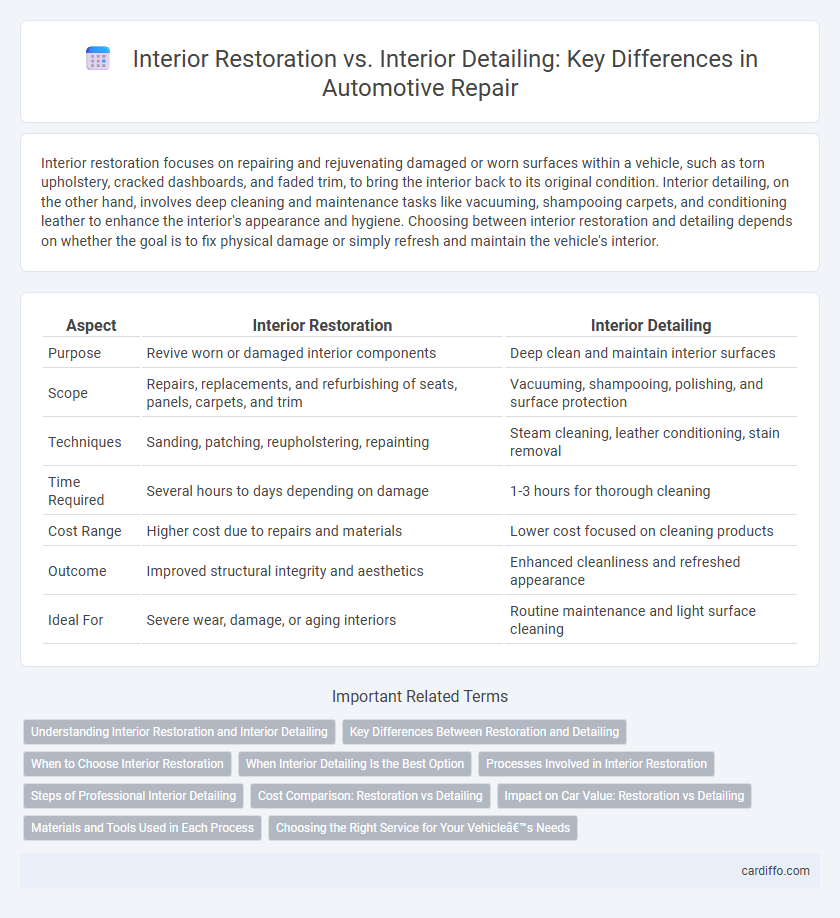Interior restoration focuses on repairing and rejuvenating damaged or worn surfaces within a vehicle, such as torn upholstery, cracked dashboards, and faded trim, to bring the interior back to its original condition. Interior detailing, on the other hand, involves deep cleaning and maintenance tasks like vacuuming, shampooing carpets, and conditioning leather to enhance the interior's appearance and hygiene. Choosing between interior restoration and detailing depends on whether the goal is to fix physical damage or simply refresh and maintain the vehicle's interior.
Table of Comparison
| Aspect | Interior Restoration | Interior Detailing |
|---|---|---|
| Purpose | Revive worn or damaged interior components | Deep clean and maintain interior surfaces |
| Scope | Repairs, replacements, and refurbishing of seats, panels, carpets, and trim | Vacuuming, shampooing, polishing, and surface protection |
| Techniques | Sanding, patching, reupholstering, repainting | Steam cleaning, leather conditioning, stain removal |
| Time Required | Several hours to days depending on damage | 1-3 hours for thorough cleaning |
| Cost Range | Higher cost due to repairs and materials | Lower cost focused on cleaning products |
| Outcome | Improved structural integrity and aesthetics | Enhanced cleanliness and refreshed appearance |
| Ideal For | Severe wear, damage, or aging interiors | Routine maintenance and light surface cleaning |
Understanding Interior Restoration and Interior Detailing
Interior restoration involves repairing and replacing damaged or worn components to return a vehicle's interior to its original condition, addressing structural issues, upholstery damage, and aging materials. Interior detailing focuses on thorough cleaning, conditioning, and minor touch-ups to enhance aesthetics and maintain cleanliness without extensive repairs. Both processes contribute to vehicle upkeep but differ in scope, with restoration aimed at renewal and detailing centered on preservation.
Key Differences Between Restoration and Detailing
Interior restoration focuses on repairing and replacing damaged or worn components to bring the interior back to its original condition, while interior detailing emphasizes thorough cleaning and surface conditioning to enhance appearance without major repairs. Restoration often involves tasks like reupholstering seats, fixing cracks, or replacing trim, whereas detailing includes vacuuming, shampooing carpets, and polishing surfaces. The key difference lies in restoration's goal to renew functionality and structure versus detailing's purpose to maintain and improve cleanliness and aesthetics.
When to Choose Interior Restoration
Interior restoration is essential when your vehicle's interior shows significant wear, such as torn upholstery, cracked dashboards, or faded surfaces that detailing cannot fix. Choose interior restoration to address structural repairs, replace damaged materials, and restore original aesthetics for a like-new feel. Detailing is more suitable for routine cleaning and minor cosmetic touch-ups, while restoration revives severe interior damage.
When Interior Detailing Is the Best Option
Interior detailing is the best option when the goal is to maintain or enhance the cosmetic appearance of vehicle surfaces without addressing structural damage. It involves deep cleaning and restoring interior elements like upholstery, carpets, and dashboard materials to remove stains, odors, and dust. This method is ideal for routine upkeep and improving resale value, whereas interior restoration targets repairs and replacement of damaged components.
Processes Involved in Interior Restoration
Interior restoration involves comprehensive processes such as deep cleaning, fabric repair, reupholstering, and replacing damaged components to return an interior to its original condition. This contrasts with interior detailing, which primarily focuses on surface cleaning and minor maintenance like vacuuming, dusting, and polishing. Restoration requires specialized skills in materials repair, stain removal, odor elimination, and sometimes structural fixes to restore functionality and aesthetics.
Steps of Professional Interior Detailing
Professional interior detailing involves a systematic process starting with thorough vacuuming to remove dust and debris from carpets, seats, and mats. Following this, surfaces such as dashboards, door panels, and consoles undergo deep cleaning using specialized brushes and detergents to eliminate stains and grime. The final step includes conditioning leather and upholstery to restore moisture, enhance appearance, and protect against future wear and fading.
Cost Comparison: Restoration vs Detailing
Interior restoration generally involves comprehensive repairs and replacement of damaged materials, resulting in higher costs ranging from $1,000 to $5,000 depending on the severity of wear and tear. Interior detailing focuses on deep cleaning and minor cosmetic improvements, typically costing between $100 and $300 for a standard vehicle. The significant cost difference is due to restoration addressing structural damage and material degradation, whereas detailing primarily enhances surface appearance and cleanliness.
Impact on Car Value: Restoration vs Detailing
Interior restoration significantly enhances car value by addressing worn or damaged components, replacing upholstery, and restoring original features to factory condition, which appeals to collectors and buyers seeking authenticity. In contrast, interior detailing improves car value by deep cleaning, conditioning, and protecting surfaces, preserving the vehicle's appearance without extensive repairs. Restoration offers a higher return on investment for classic or high-end cars, while detailing maintains and slightly boosts value for everyday vehicles.
Materials and Tools Used in Each Process
Interior restoration involves the use of specialized materials such as leather conditioners, fabric repair kits, and upholstery adhesives to repair or replace damaged surfaces, often requiring tools like steam cleaners, stitching machines, and sanding blocks. Interior detailing utilizes cleaning agents, waxes, and protectants combined with brushes, microfiber cloths, and vacuum systems to thoroughly clean and preserve surfaces without altering or repairing structural components. The restoration focuses on material replacement and structural repair, while detailing emphasizes surface maintenance and protection using different sets of materials and tools tailored for each purpose.
Choosing the Right Service for Your Vehicle’s Needs
Interior restoration focuses on repairing and replacing worn or damaged components to bring your vehicle's cabin back to its original condition, addressing issues like torn upholstery, faded trim, and cracked dashboards. Interior detailing enhances the cleanliness and appearance through deep cleaning, stain removal, and odor elimination, improving aesthetics without making structural repairs. Selecting between restoration and detailing depends on your vehicle's condition and goals, with restoration suited for significant wear and detailing ideal for routine maintenance and cosmetic uplift.
Interior restoration vs interior detailing Infographic

 cardiffo.com
cardiffo.com